Explanation of the symbols on the instrument panel
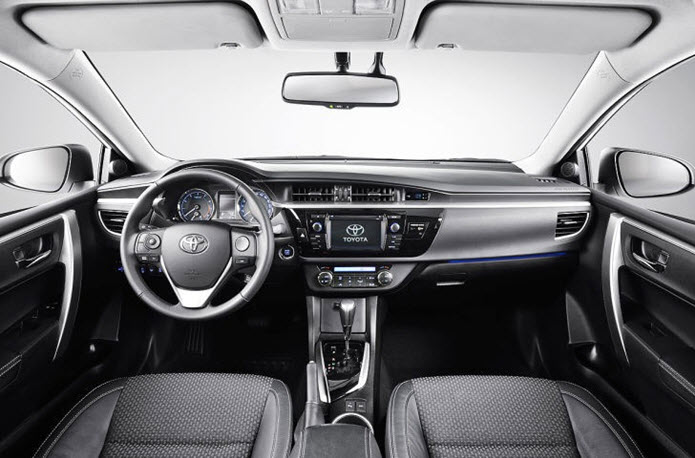
There are various warning lamps and indicator lights located on the vehicle dashboard. They describe the condition of the vehicle and also indicate when maintenance is required. Some drivers have no idea about the true meaning, but mistakes can be critical.
Why are the signs on the panel important?
The designation of all icons on the instrument panel will allow you to clarify the condition of the machine. Every driver should know about this, because the color indication tells you when to pay attention to a particular point. Every malfunction is instantly noted, since modern vehicles are literally crammed with sensors.
Each icon or indicator carries information about the state of a particular component of the car or engine.
Each icon has its own meaning.
Some are installed for the engine, others for the fuel system, and others for the steering. Decryption will definitely be required for a driver who wants to maintain his own car in excellent condition.
When the light comes on, you need to immediately know exactly what happened.
Difference in color indication
Shield signs are important information. It is transmitted in a variety of ways, such as blinking, but usually color should be taken into account when assessing the condition of the engine and systems. What notations can be compared to reach the correct conclusions?
- Green or blue color – normal operation of the node or system.
- Orange or yellow color – urgent service required.
- Red color – a breakdown has occurred.
When the light bulbs come on, you will have to immediately deal with the problem. Often delays lead to serious consequences, in particular, to the mandatory replacement of a particular part. You shouldn’t wait for such a moment, as certain types of engine repairs cost a pretty penny.
Basic icons on the dashboard
The main icons on any dashboard remain constant. Drivers know them well, as they have not changed for many decades. Yes, now additional indicators for the engine and systems are constantly appearing, but they are usually evaluated only in individual cases. What main designations are important?
- Hand brake;
- Cooling;
- Engine oil;
- Battery.
Main indicators on the dashboard
Engine gauges keep changing. The devices describe his condition, so you cannot refuse them. Only taking into account the available data can you safely drive on the roads without fear of breakdown. Moreover, you first need to find out what each basic sign means, and then move on to the subtleties.
Hand brake
The red exclamation mark is the main indicator, whose description suggests that the handbrake is on. It can only light up when stopping, so before starting, you should pay attention to this mark. Otherwise, a serious breakdown will occur that cannot be repaired on site.
Warning lights always indicate possible troubles, and red indicates the need to shut down. Accordingly, the driver needs to check the status of the instruments before turning the key.
Cooling
Cooling is indicated by an additional indicator. Yes, you can always check the temperature, but it is much easier to take into account the color of the indicator. When the yellow light comes on, it is better to stop and check the temperature of the radiator. If the indicators exceed the operating values, you urgently need to cool the machine. Overheating leads to serious damage that you can rarely fix on your own.
Shield signs - important information
If a similar signal lights up on the dashboard of your car, delays create unnecessary danger. The owner should think about this. Otherwise, right in the middle of the trip, he will have to go to a service station for detailed diagnostics and repairs.
Engine oil
If a small oil leak appears, you will have to add or change engine oil. When such icons light up, professionals immediately stop. Why should this be done? The quantity is checked using an indicator, but a deficiency leads to increased wear.
When parts are in this condition, they gradually deteriorate. The result will likely be major repairs and replacements, so delays are unacceptable. In just a few minutes the engine can fail, so it's easier to just add oil.
Battery
The dashboard of a car or truck includes several important signs, among which the battery stands out. It charges while driving, but before it breaks. If the driver sees a red signal, he knows that the charge has reached the minimum level. In such cases, external charging will be required; there is no other way to start the engine.
The battery may also break. A red indicator will also be marked, indicating the need for replacement. Because of this, this sign has not changed over the years.
Driving and maintaining a car is a real art. By reading the signs correctly, you can understand the condition of all systems and what repairs may be required. So information about them remains relevant for every owner who is trying to avoid going to workshops.
Source: http://www.AvtoKrasim.ru/znachki-na-paneli-priborov-informaciya-o-sostoyanii-avtomobilya/
What do the signs on the Toyota dashboard mean?
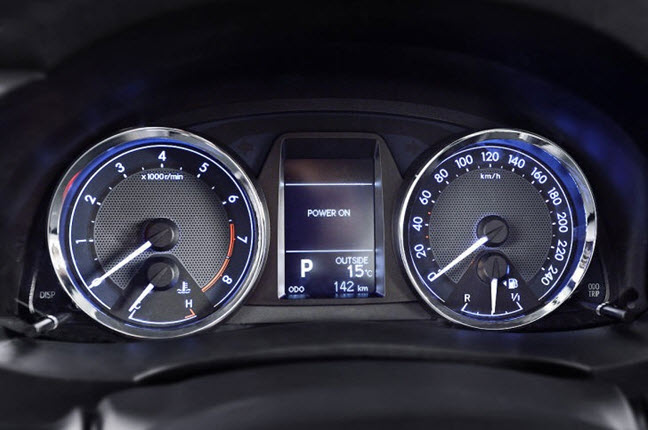
There are a lot of these signs; they are intended for all occasions on the road.
Some notify about the occurrence of possible problems, others notify about the functioning of individual parts of the vehicle, and others clearly declare an existing breakdown.
One of the most multifaceted meanings on a car panel are Toyota icons. Today we will talk about them in detail so that you know what they mean.
In the case of calm movement, you do not need to know what this or that picture means. They will never make themselves known if everything is fine.
But we must always be prepared for troubles in order to know how to deal with them. People say that even once a year the stick shoots, so one of the most prestigious brands can fail. No one has canceled factory defects.
Some values on the dashboard of cars from global manufacturers are very rare. We will talk about the most pressing problems that may arise when operating a Toyota car.
Don't panic if any indicator lights up. Keep in mind that some labels may indicate that the machine has some kind of malfunction. However, the specific problem will not be named. When a similar icon appears on the panel, you should come to the diagnostic center.
Airbags
When this icon lights up, there is some problem with the airbags in your car. The system must be checked by specialists. If you have disabled the protective function yourself, this signal will also appear.
Anti-lock braking system failure
Indicates that an error exists or that the device should be replaced. If one of the devices is very dirty, then an indicator will appear. Also, when your car was operating in sport mode, a signal appears. If the vehicle's wheels suddenly begin to slip, the system will work in the same way.
Motor failure
This signal warns that the device has broken down or a system failure has occurred and the motor has stopped functioning normally, as a result of which it releases a large amount of harmful components into the atmosphere.
If the engine makes any unnecessary sounds, you need to worry. But you need to go to the station in any case.
Oil pressure
When this indicator appears, keep in mind that there is not enough pressure or it is too high. Be sure to check it before you get behind the wheel. The label indicates a breakdown of the pump or a plug in the line.
Low engine coolant temperature
This temperature is not suitable for your engine, which is why the icon appears. If it does not disappear, you should contact a specialist. An engine that is not operating at the correct temperature will consume more gasoline and release more pollutants into the environment.
Low beam
The indicator indicates that the lights or dimensions are on. If there is an exclamation mark, it is advisable to check the headlights.
Maintenance needs
Notifies that oil and filters need to be replaced as part of routine technical service.
Sign warning of insufficient fluid volume
Requires you to add liquid to the washer tank.
Need to refuel
When the last indicator bar appears on the panel, you should visit a gas station.
Electric power steering system
Indicates that certain problems have arisen with the electric amplifier. You will know this when the steering wheel becomes heavy. Be sure to go to the service.
Open door icon
Indicates that the car door structures need to be closed.
Parking brake
Indicates the brake is raised. If you release it and the icon does not disappear, then there is most likely a problem and you should have your brakes checked. They may need replacement.
High coolant temperature
The motor is very hot, which can lead to irreparable consequences. Turn it off and call a specialist or take the car to a service center. Be that as it may, you need professional help.
Fog lights
Notifies you that the fog lights are on.
Dimensions
Informs when the parking lights are turned on.
High beam
This means the high beams are on. Make sure you don't blind other cars.
Turn signals
Indicate that the turn signals are on or that the hazard warning lights are operating.
Battery warning light
As a rule, it indicates that the battery is not charging correctly or is not being recharged at all.
Safety belt
You need to buckle up.
Transmission operation
Indicates a transmission failure. Occurs when the box stops functioning. You should not drive the car yourself when the indicator lights up.
Fuel filter icon
If it lights up, this indicates that water has appeared. Don't be hysterical if you were driving. You have time to come to the service center and fix this problem.
Glow plugs
It occurs if it is cold outside and indicates that the spark plugs in the engine have begun to warm up the combustion chamber. Do not start the engine until the icon goes out. If it does not disappear for a long time, it means a breakdown has occurred.
STOP icon
It's normal if it occurs when you turn on the ignition, but if it doesn't go away, you should stop.
Cruise control
Notifies you that the system is operational. If you wish, you can turn it off by applying the brakes.
Gear position
Displays what gear you are in.
Vehicle stability control
If it does not disappear, it indicates the existence of a breakdown in one of these systems.
Tire pressure
Indicates incorrect tire pressure. Warns of a puncture.
Disabling traction control
Notifies you that your traction control system is disabled.
Car sliding
It turns on when you start to move through snow, mud or moisture. The machine slips and the traction functions to provide maximum traction.
Overdrive Off
Indicates that the overdrive system is operating.
Oil temperature warning
The oil temperature is very high and therefore you need to reduce your speed or stand still.
To be fully aware of your car's system, read the user manual. Never speed and move carefully. Constantly undergo technical maintenance, use only original spare parts and fluids.
" Back
Source: https://AutoGarant.su/articles/chto-znachat-znaki-na-paneli-toyota-68.html
Designation of icons on the instrument panel: warning lamps
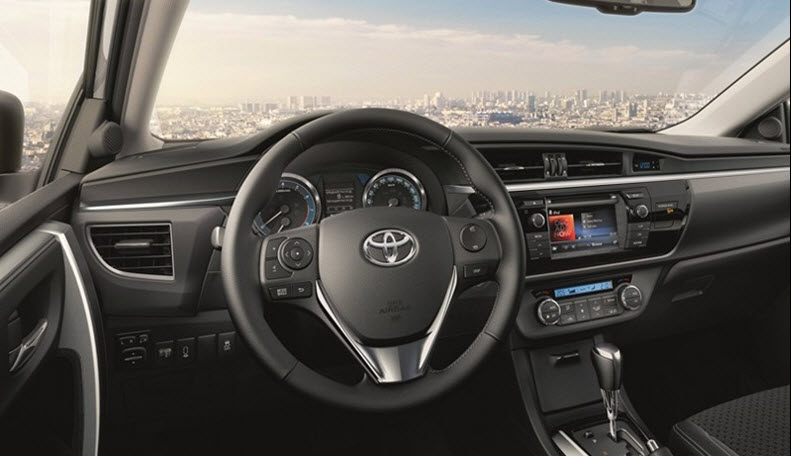
Good day, dear colleagues and blog readers! A modern car is such a complex device from a technical point of view that few people truly understand its design.
Every year it is filled with more and more electronics on board, the functionality of which takes time to get used to. Most devices and systems are equipped with their own indicators, which are displayed on the dashboard.
They signal exactly how a particular device operates and when a malfunction occurs, and also issue alarm messages. The designation of icons on the instrument panel is the topic of our discussion today.
Why are indicators displayed on the panel?
The main purpose of such icons is to inform the driver about all potential malfunctions, as well as about the operation of key and auxiliary vehicle mechanisms. If you remember the dashboard of VAZ cars of the Soviet era, the first thing that comes to mind is simplicity and asceticism.
Even the indicators themselves were primitive in the form of yellow or red light bulbs. However, they also fulfilled their important mission, of course, if they worked properly.
Over time, indicators became more attractive and effective.
The era of digitalization has also affected these modules, making them not just ergonomic, but entire elements decorating the dashboard and interior of a modern car.
Signal color
Now let's look at the description of the main indicators, as well as the criteria by which they are displayed on the dashboard. Understanding them will allow the driver to quickly understand all their diversity.
One of the most important points is the color of the light bulb. A red warning light on a vehicle indicates potential threats to vital vehicle systems, such as oil pressure or coolant levels. If the color is yellow or orange, it means that the time for repair or replacement of one or another element is approaching.
The green indicator does not indicate any danger. Its main purpose is to inform the driver that the system is working properly, so you should not be afraid of such designations.
How to monitor vital systems
Now let's talk about the most important and potentially dangerous symbols that you need to pay attention to first:
- “Oiler” lights up if the oil pressure level drops below the maximum permissible level. When you turn the key in the ignition, the icon may light up, but in the next seconds it should go out. If the lamp continues to burn, then the reasons and solutions can be found here;
- a red circle with an exclamation mark inside lights up when the driver uses the parking brake (hand brake). In all other cases, its appearance indicates a malfunction of the brake system, and therefore it is necessary to immediately go to a service station, since the brakes are bad;
- The stylized image of a thermometer with a scale refers to the car's cooling system. If the icon is red, this may indicate that the engine is boiling. In this case, it is necessary to stop its operation, allow it to cool and check again. A flashing indicator may indicate electrical problems;
- the image of the battery will tell us about a drop in the voltage level in the on-board network. If it does not appear when starting, but while driving at speed, then there may be problems with the operation of the generator, which is designed to charge the battery while driving.
Other important icons and symbols
Another signaling device, which is installed on all modern cars, including Volkswagen, is called “CHECK” or “CHECK ENGINE”. It suggests that one of the systems or critical engine parts is faulty. As a rule, we are talking about unstable engine operation (tribbing), ignition faults, weak torque, and poor-quality composition of the combustible mixture.
Those drivers who periodically forget to close the fuel tank cap should pay attention to the icon of a car with an open cap.
Many models of modern imported vehicles are equipped with this indicator. There are also symbols that indicate that the time has come for a scheduled technical inspection.
They can vary, but most often have a picture of a car with the word SERVICE at the bottom.
The significant proliferation of automatic transmissions has led to the appearance of various variations of badges. The simplest of them looks like yellow AT letters against a black square background. The designation A/T OIL Temp and others may also appear.
Anything associated with this may mean insufficient oil level in the automatic transmission, its overheating or locking mode.
As with the engine, all icons that indicate the health of the transmission should be given top priority.
Modern cars boast many safety systems that did not exist before.
Everyone already knows such concepts as traction control, anti-lock braking systems, car stabilization system, and so on.
If the letters are highlighted in green, this indicates that the systems are operating normally. Yellow color will indicate that the system is turned off or if there are any malfunctions in its operation.
Why is it necessary to monitor the images on the “tidy”
We will not describe the usual indicators in detail. Let me briefly remind you that the gas station icon indicates insufficient fuel level and the need to refuel in the near future. If a car is shown with the doors wide open, it means that the hood, trunk or some door is not closed as it should be.
You need to get used to the main indicators, which constantly light up in the same color on the board, but check their condition regularly.
Any deviation indicates that the vehicle's functionality should be checked.
In some cases, we may be talking about adding oil or antifreeze, a broken electrical wiring, a burnt-out sensor, and in others, it could be an expensive repair if measures are not taken in a timely manner.
For those who want to get acquainted with all the badges on various types of vehicles, be it Toyota, Nissan or any other brand, there are numerous photo images on the Internet. Do not forget that only regular maintenance and technical control will help protect your car from potential and dangerous malfunctions on the road. Be careful and see you later!
Sincerely, blog author Andrey Kulpanov
Source: http://avto-kul.ru/poleznoe-ob-avtomobile/oboznachenie-znachkov-na-paneli-priborov.html
TOYOTA COROLLA
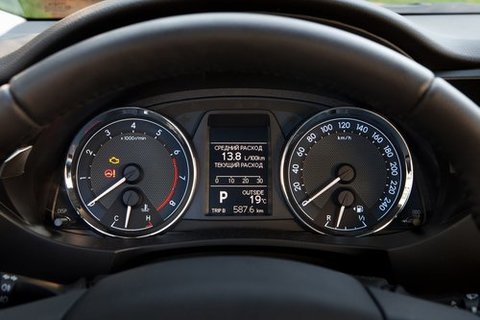
DASHBOARD
The following controls and instrumentation are located on the instrument panel. For ease of use, the handles, buttons and control devices located on the instrument panel are marked with symbols of their functional purpose.
1 – nozzles of the interior ventilation and heating system are designed to regulate the air flow from the heater, air conditioner or ventilation system. The direction of air flow is adjusted by turning the deflectors in the appropriate direction.
At the bottom of the nozzles there is a handle for adjusting the amount of air supplied through them.
When the handle is turned all the way to the right, the damper opens completely (maximum air flow). When the handle is turned all the way to the left, the damper closes completely, cutting off the air flow. By placing the handle in intermediate positions, the amount of air flow is adjusted.
2 – lever for switch of external lighting and direction indicators. The lever switches the following operating modes of the switch:
– mode of turning on the direction indicators.
Move the lever up or down until the turn indicators turn on. When you move the lever up or down in the instrument cluster, the indicator 10 or 7, respectively, starts flashing.
When the steering wheel is returned to the straight-ahead position, the lever is automatically returned to its original position.
When changing lanes, to turn on the turn signal, it is enough to press the lever in the up or down direction only until the moment of noticeable resistance, without fixing the lever. When released, the lever will return to its original position;
NOTE
The turn signal only works when the ignition is on.
– mode of turning on the headlights.
To turn on the headlights, turn handle A of the switch lever around its axis. When the headlights are turned on, the switch can have two positions:
– everything is turned off;
– the side lights in the front and rear lights are turned on, as well as the illumination of the instrument cluster;
– low beam is on. To switch the headlights from low beam to high beam, move the lever away from you. When the high beam headlights are turned on, the warning light in the instrument cluster lights up.
To signal high beam headlights, move the switch lever one position towards the steering wheel (the exterior lighting switch knob must be in position) and release.
To turn on the fog lights, turn switch B and align with the icon.
To turn off the fog lights, turn switch B to the “OFF” position.
3 – lever for manual downshifting in the gearbox (see “Gearbox Control”).
4 – steering wheel. The following switches and keys are located on the steering wheel:
– horn switch. To turn on the sound signal, press anywhere on the steering wheel pad;
– Bluetooth system keys with the ability to control the phone and a button to turn on the speed limiter: A – button to answer incoming phone calls; B – speakerphone switch;
B – speed limiter button;
– audio system control keys from the steering wheel. The buttons located on the left side of the steering wheel can be used to control certain audio system functions. A – volume key; B – file selection key, search for radio stations or fast forward and backward movement;
B – audio system power switch.
5 – instrument cluster (see “Instrument cluster”).
6 – ignition switch (lock), combined with an anti-theft device, is located on the right side of the steering column. The key in the lock can be in one of four positions:
LOCK – the ignition is turned off, and the anti-theft device is turned on when the key is removed. To ensure that the steering shaft is locked, turn the steering wheel to the right or left until it clicks. To turn off the anti-theft device, insert the key into the ignition switch and, turning the steering wheel slightly left and right, turn the key to the “ACC” position;
WARNING
Do not turn off the ignition or remove the key from the lock while driving: the steering will be locked and the vehicle will become uncontrollable.
ACC – ignition is turned off, the key is not removed, the steering is unlocked. The power supply circuits for the sound signal, external lighting, high beam headlight alarm, and radio equipment are included;
ON – the ignition is on, the key is not removed, the steering is unlocked. The ignition, instruments and all electrical circuits are turned on; START – the ignition and starter are turned on, the key is not removed, the steering is unlocked. This key position is not fixed; when released, the key returns to the “ON” position under the force of the spring.
NOTE
In a variant version, the car can be equipped with an intelligent Push Start engine starting system.
WARNING
On Toyota Corolla cars, you can start the engine only by pressing the brake pedal (models with robotic and automatic transmission) or the clutch pedal (models with manual transmission).
7 – lever for manual overdrive in the gearbox (see “Gearbox Control”).
8 – cleaner and washer switch lever with a button for switching display modes of the on-board computer.
The switch turns on electrical circuits when the ignition is on. The lever can be in the following positions: 0 – the windshield wiper is off; I – intermittent mode. To turn it on, move the steering column switch up to the first fixed position.
To change the duration of the pause, turn switch A clockwise (long pauses) or counterclockwise (short pauses). Switch A sets four modes of intermittent wiper operation. II – slow mode.
To turn it on, move the steering column switch up to the second fixed position; III – fast mode. To turn it on, move the steering column switch up to the third fixed position. IV – short-term mode.
To turn it on, move the steering column switch down.
By moving the steering column switch towards you, you turn on the windshield washer (non-fixed position). When you press the steering column switch simultaneously with the washer, the windshield wiper will automatically turn on, the blades of which will complete two working cycles.
NOTE
The windshield wipers operate only when the ignition is on and the hood is closed. If there is a foreign object on the windshield, the wiper attempts to remove the object. If an obstacle continues to block the wiper, it stops working. Remove the obstruction and turn the windshield wiper back on.
9 – alarm switch. When you press the switch button, all direction indicators and warning lights installed in the instrument cluster light up with a flashing light. When you press the button again, the alarm is turned off.
NOTE
The hazard warning lights operate in any position of the key in the ignition switch (lock).
10 – audio system head unit (see “Audio system head unit”).
11 – control unit for the heating, air conditioning and interior ventilation system (see “Heating, air conditioning and interior ventilation”).
12 – upper glove box (see “Interior storage boxes”).
13 – front passenger airbag installation area. When combined with a seat belt, the airbag provides protection to the occupant's head and chest during a severe frontal collision.
WARNING
The airbags do not deploy: – when the ignition is switched off; – in light frontal collisions; – in light side impacts; – in collisions; – in rollovers.
14 – lower glove box (see “Interior storage boxes”).
15 – front seat heating switches.
16 – ashtray with cigarette lighter (see “Ashtrays”).
17 – gearbox control lever (see “Gearbox Control”).
18 – parking brake lever.
To brake the car with the parking brake, lift the lever all the way up - indicator 25 in the instrument cluster will light up red.
To release the brakes of the car, pull the lever up a little, press the button at the end of the lever handle and lower it all the way down. The warning light should go off.
19 – accelerator pedal.
20 – brake pedal.
21 – handle for adjusting the steering wheel position. The car is equipped with a steering column that is adjustable in tilt and reach. Before driving, adjust the position of the steering wheel so that it is convenient to drive the car and at the same time the instruments in the combination are clearly visible.
NOTE
We recommend adjusting the steering column only after you have placed the seat in a comfortable position.
WARNING
Adjust the steering wheel only when the vehicle is stationary. If, when trying to make adjustments while driving, you do not firmly fix the steering column and it moves unexpectedly, you may lose control of the vehicle.
To select the optimal steering wheel position, lower the lever down.
Set the steering wheel to the desired position.
Lock the steering column by moving the lever to its highest (home) position.
22 – diagnostic connector.
23 – drive of external rear-view mirrors (see “Rear-view mirrors”).
24 – hood lock drive lever. By turning the lever towards yourself, the hood lock is unlocked. At the same time, the front edge of the hood is raised, creating a gap for access to the hood safety hook handle.
25 – box for small items.
26 – block of switches for headlight range control and headlight washer. To turn on the headlight washers, turn on the headlights and press switch A.
Headlight corrector B is equipped with an electric drive and allows you to smoothly change the angle of the headlights in accordance with the vehicle load, which prevents dazzling oncoming drivers. At the same time, correct adjustment of the headlights ensures visibility for the driver.
Headlight level adjustment has six positions (0, 1, 2, 3, 4, 5) and is only possible when the low beam is on.
The position of the regulator approximately corresponds to the following loading states: 0 – one driver; 1 – driver and front passenger; 2 – all seats are occupied, trunk is empty; 3 – only the driver’s seat is occupied, the trunk is fully loaded; 4 – driver and passenger in the front seat, trunk fully loaded;
5 – all seats are occupied, trunk is fully loaded.
Source: http://ToyotAuto.net/corolla/panel-priborov.html
Toyota Corolla dashboard
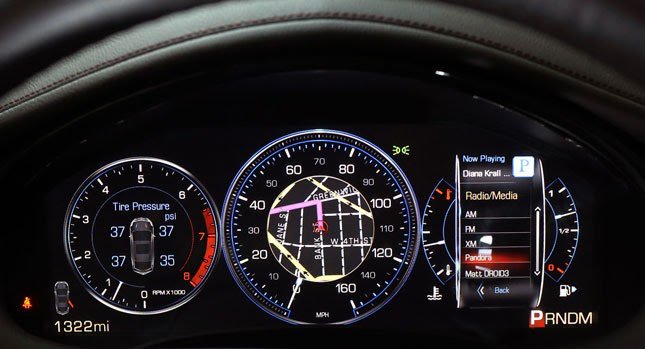
The instrument panel on a Toyota Corolla is the space on which control and measurement sensors are located, as well as levers and car control buttons. To make it more convenient for the owner to use the car, the manufacturer tried to put a corresponding design on each button and lever, that is, the symbolism of what this tool is responsible for.
At the front there are so-called nozzles that help ventilate the interior, as well as heat it through the stove. It is through them that not only hot, but also cold air enters the instrument panel.
You can adjust the air flow at your own request using deflectors. There is a special lever on the bottom that helps adjust the amount of air supplied.
If you turn the handle all the way, the air will stop flowing into the cabin altogether.
The instrument panel on the left has a front light switch as well as a vehicle turn signal. This lever on the Toyota Corolla works in several modes, including when turning on the turn. When the steering wheel is turned in a straight line, the lever itself returns to its place. It is worth noting that the lever can only indicate turning if the ignition system is turned on.
The second mode of this element is headlights and lighting adjustment. The driver can either turn off all the headlights or activate the high or low beam and dimensions. A downshift switch was also installed on the instrument panel.
There are many buttons on the steering wheel, there is not only a sound signal, but also Bluetooth, and the ability to activate the speed limit. When connecting the phone to the car, you can turn on the speakerphone from this panel and answer calls as usual.
On the left side of the steering wheel there are keys responsible for the functions of the audio system. You can adjust the volume, quickly search for the required file, navigate between radio stations, and turn on the power.
The ignition switch is located on the right under the steering column. The driver can place the key in the lock in any of four possible positions.
The LOCK mode on the Toyota Corolla indicates that the ignition system is turned off; if the key is not in the lock, the alarm is activated. To accurately lock the steering shaft, simply turn the steering wheel to the right until a click is heard.
To turn off the anti-theft equipment, simply insert the key into the lock and turn the steering wheel to the ACC position. You cannot remove the key while driving along the highway, otherwise the steering wheel will lock and the Toyota Corolla will be uncontrollable.
The ACC position means that the steering wheel is unlocked and the power, lighting and radio systems are activated. The key is in ON mode, when the ignition is turned on, the electrical circuits in the car are connected to the operation.
As an option, the Toyota Corolla can be equipped with an intelligent power unit starting system.
On this car, you can start the engine only by pressing the brake if the gearbox is automated or the clutch if it is manual.
Drivers found the overdrive and washer switches to be very useful. The electrical circuits come into operation only when the ignition system is turned on; here it is worth remembering that 0 means complete shutdown of the wiper, 1 - intermittent operation, 2 - slow, 3 - fast, 4 - short-term.
It is important to know that the windshield wiper can only operate if the hood is closed and the ignition is turned on. During the first minutes of operation, the mechanism will try to cope with the presence of a foreign body on the glass; if this fails, it will stop.
The hazard warning switch is very important in the operation of the Toyota Corolla, which can come in handy in an unexpected situation right on the highway. To activate it, just press the button, as well as to disable it. This function works regardless of the position of the key in the ignition switch.
The instrument panel also contains the main audio unit, vehicle heating controls, storage compartments, heated seats, gearbox controls, and parking brake. There is also an area where an airbag is installed, which will not work if the ignition is turned off, a minor collision, a collision or rollover of the car.
The handle for adjusting the steering wheel is very useful for Toyota Corolla drivers. Before the trip, you can easily set the required steering wheel position depending on the required level of inclination and reach. This will make driving the car even more comfortable.
Professionals recommend adjusting the steering wheel only after the seat has been properly adjusted, so that there is not only a good view of the road, but also of the combinations and instruments on the steering wheel.
All manipulations are carried out exclusively with a stationary car; if you do this while driving on the highway, you may temporarily lose control of the car.
To set the desired position of the steering wheel, simply lower the lever, select it and move it to fix it in its original place.
For technical inspection of the machine, a connector for connecting diagnostic devices is provided on the front panel. There is also a drive for the outside rear-view mirrors and a hood lock switch, which raises the front edge. Thanks to a small gap, the driver is able to move the safety hook and look inside the engine compartment.
The manufacturer also took care of the headlight washer switch and the light corrector. To activate the washer, simply turn on the lights and press A. The letter B activates the light corrector, which allows you to adjust the angle of the front lighting. Thanks to this feature, drivers driving in the oncoming lane will not be blinded by lights at night.
The headlights can be adjusted in six available positions and only with active low beam. Position 0 means that the driver is alone in the car, position 1 - front passenger and driver, 2 - all seats are occupied, but the trunk is empty, 3 - the trunk is full, only the front seats are occupied, position 5 - the trunk is full, all seats are occupied.
As we can see, the manufacturer has done a good job on the capabilities of the front panel of the Toyota Corolla. Its design provides all possible and most useful functions that the driver can activate without leaving his seat.
Thanks to these features, not only has control become more convenient, but the car itself has reached a new level of internal comfort.
Each instrument button and lever has a graphic image, so even a beginner will not have problems understanding the functions of a particular switch.
Source: http://CorollaCar.ru/ekspluataciya/panel-priborov-tojota-korolla.html
Toyota Corolla E150 (2010+). INSTRUMENT CLUSTER
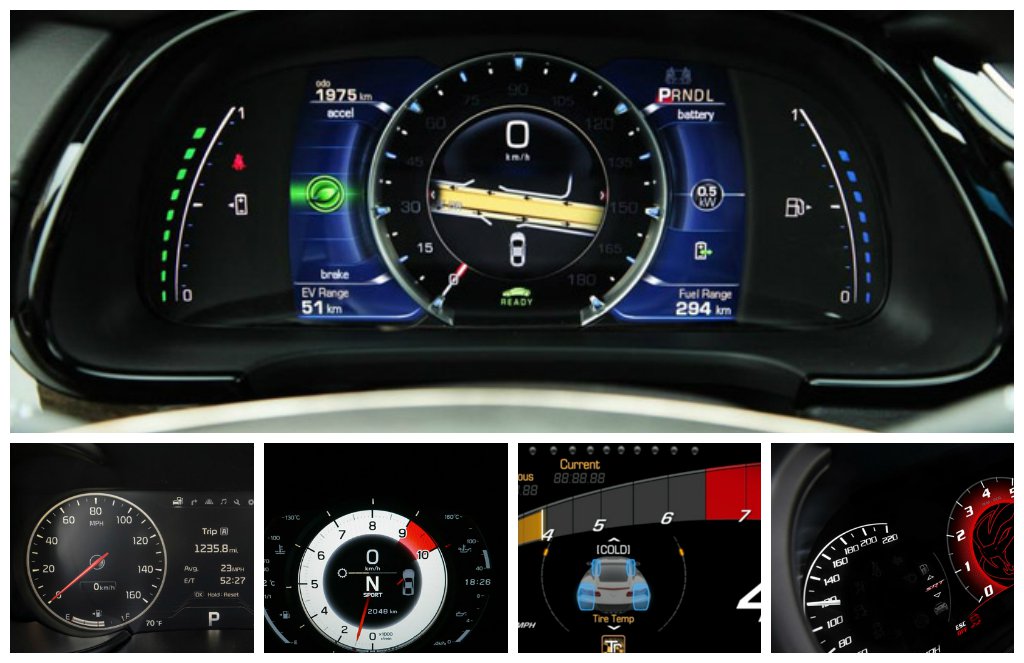
Location of instruments and signaling devices in the instrument cluster:
(for diesel engines).
car (see “Car speed limiter”)
(with an orange filter). Lights up when the ignition is turned on and lights up when the engine is started.
Immediately after starting the engine, the warning light should go off.
If the warning light comes on while the engine is running, it indicates a malfunction in the engine management system. In this case, the control unit switches to the backup program, which allows you to continue driving.
When the indicator lights up, it is necessary to check the control system and eliminate the malfunction.
WARNING
Long-term operation of the vehicle with the warning light on is not recommended, as it can lead to increased fuel consumption, deterioration of the vehicle's traction characteristics and engine breakdowns.
If the indicator flashes, it means that there is no stable spark generation in the ignition system. Reduce engine speed until the warning light goes off. Contact a service station as soon as possible or have the problem repaired.
.
shows the engine speed. The scale is graduated from 0 to 8, division value is 0.2. To find out the crankshaft rotation speed in min–1, you need to multiply the tachometer readings by 1000.
. When the ignition is turned on, the following information is displayed on the left information display: A – fuel level; B – liquid temperature in the engine cooling system;
B – position of the gear lever.
(in the form of an arrow with a green filter) lights up with a flashing light when the left turn signal is turned on (synchronously with it). Flashing of the indicator with double frequency indicates a burnt-out lamp in any left turn indicator. If the indicator does not light up or lights up constantly, it means that there is a malfunction in the electrical circuits of the turn signals.
(with a blue filter) lights up when the high beam headlights are turned on.
(with a green filter) lights up when the side lights in the headlights and rear lights are turned on.
(in the form of an arrow with a green filter) lights up with a flashing light when the right turn indicator is turned on (synchronously with it). Flashing of the indicator with double frequency indicates a burnt-out lamp in any right direction indicator. If the indicator does not light up or lights up constantly, it means that there is a malfunction in the electrical circuits of the turn signals.
shows how fast the car is currently moving. The scale is graduated from 0 to 240, the division value is 5 km/h.
. When the ignition is turned on, the following information is displayed on the right information display: – outside air temperature; - watch; - date of; – information about the trip (distance traveled, fuel consumption, etc.); – warning messages (if a malfunction occurs in one of the vehicle systems); – average speed of the car;
– actual duration of time from the moment the engine starts.
When the rear fog lamp is turned on, it lights up when the light in the rear fog lamp is turned on.
brakes and emergency braking systems. The indicator lights up orange when the ignition is turned on, and goes out after the engine starts. If the indicator lights up when the engine is running, it indicates a malfunction of the anti-lock braking system.
WARNING
In all other cases, the lighting of the anti-lock braking system indicator indicates a malfunction that must be repaired at a specialized vehicle service station, since in all cases braking occurs without the participation of the anti-lock braking system and the emergency braking system.
adjusting the headlight beam angle (on vehicles equipped with gas-discharge headlights).
. When the ignition is turned on, the indicator lights up and goes out after a few seconds.
additional passive safety system. The warning light (with a red filter) lights up when the ignition is turned on and stays on for about 6 seconds. and goes out if the system is working properly, and does not go out (or lights up while driving) if there is a malfunction in the airbag system.
WARNING
If the warning light comes on, immediately contact a car service center. In addition to the possible failure of the airbag in an emergency, it may unexpectedly deploy while driving, which will lead to serious consequences.
engine preheater (for diesel engines).
security. Lights up red when the ignition is turned on if the driver and front passenger seat belts are not fastened. Simultaneously with the indicator light coming on, an intermittent buzzer sounds.
WARNING
Be sure to wear your seat belt and do not carry passengers in your vehicle who are not wearing seat belts!
speed limits (see “Vehicle speed limiter”).
and a button for switching modes of the right information display (trip counter, reset of daily mileage readings).
(for cars with manual and robotic transmissions).
car systems. Lights up with a flashing light when faults are detected in the vehicle systems, which are displayed on the right information display.
right information display (outside temperature, date, fuel consumption, average speed).
and the state of the brake system (with a red filter) lights up when the ignition is turned on if the level of brake fluid in the master cylinder reservoir or the parking brake lever is raised excessively.
WARNING
Driving a vehicle with the warning light on is prohibited.
robotic gearbox.
in the electric steering.
(with a red filter) lights up when the ignition is turned on. Immediately after starting the engine, the warning light should go off. Illumination of the indicator or its full glow when the engine is running indicates a lack of charging current caused by a malfunction of the generator or voltage regulator, as well as weak tension (or breakage) of the auxiliary drive belt.
WARNING
Driving a vehicle with the warning light on is prohibited: in addition to the battery being completely discharged, this may indicate a short circuit in the charging circuit.
Source: http://zinref.ru/avtomobili/Toyota/002_00_Toyota_Corolla_Auris_2007_2011_remont_bez_problem_kopia/008.htm







